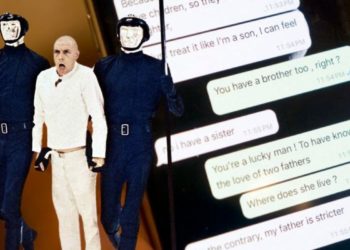Ani DiFranco’s approach to her music career has always had a stripped-down, D.I.Y. vibe. In fact, Dana Flor’s new documentary about the singer, “1-800-ON-HER-OWN” (in theaters) draws its name from the phone number for DiFranco’s Righteous Babe Records, the label she founded in 1990 so she wouldn’t have to work with a major company. It was an unusual thing for anyone to do back then, but especially for a 20-year-old female artist whose songs lay somewhere between folk and punk. That’s just her style.
The documentary mimics that handmade aesthetic, sometimes accidentally. The major arc follows DiFranco, now in her 50s and a mother of two, as she tries out collaboration as she never has before. Arriving as a guest of honor at a songwriting retreat held by Justin Vernon (a.k.a. the frontman of the band Bon Iver), she confesses that she’s never written a song with anyone else in her entire career. Yes, DiFranco has often worked with others — she toured with a band, and the label was run by a team — but her solo songwriting and a more recent solo tour have sometimes felt lonely.
DiFranco talks throughout the film about her career and her memories, often while sitting in a car. But while the film starts out conventionally, seeming as if it will focus, as she puts it, on finding “some other way to be home more and still be an artist,” it soon pivots. When the pandemic strikes, being home more is not a choice — it’s just life.
Much of the footage thus becomes the twitchy recorded video calls we remember all too well, during which DiFranco discovers that collaboration, even for an artist as revered and experienced as she is, is not a simple thing. The pandemic-era documentary, full of footage shot by a subject who never expected to have to do so, will probably be showing up on screens for a long time, and it suits DiFranco’s raw energy, her preference all along for doing things herself.
This is the kind of relatively pedestrian musician documentary that’s intended mostly for fans, who will encounter plenty of nostalgia. It’s a vulnerable glimpse at an artist figuring out what the creative life looks like in a world that keeps changing. DiFranco belongs, as one person puts it, to the “last generation born with both feet in an analog world,” one that’s more or less gone now.
But while it’s mostly a fan-service film, the movie makes a case for her continuing relevance, too. The music clearly still resonates: Archival footage from shows across eras demonstrates just how vibrant and current the songs feel, decades after DiFranco started touring. It’s still hard to be a woman in world that tends toward violence; it’s still tough to be female in a male-dominated business. “I see my life in political terms,” DiFranco says. She sees paving her own way as a path of resistance to a world built to keep outsiders on the outside. If she does it, she says, she gives space to others to do it, too.
Alissa Wilkinson is a Times movie critic. She’s been writing about movies since 2005.
The post Ani DiFranco Tried to Collaborate. Then the Pandemic Hit. appeared first on New York Times.




